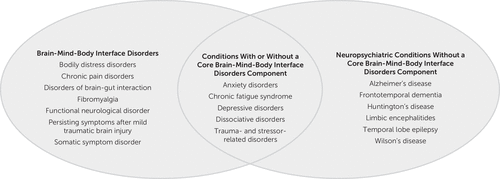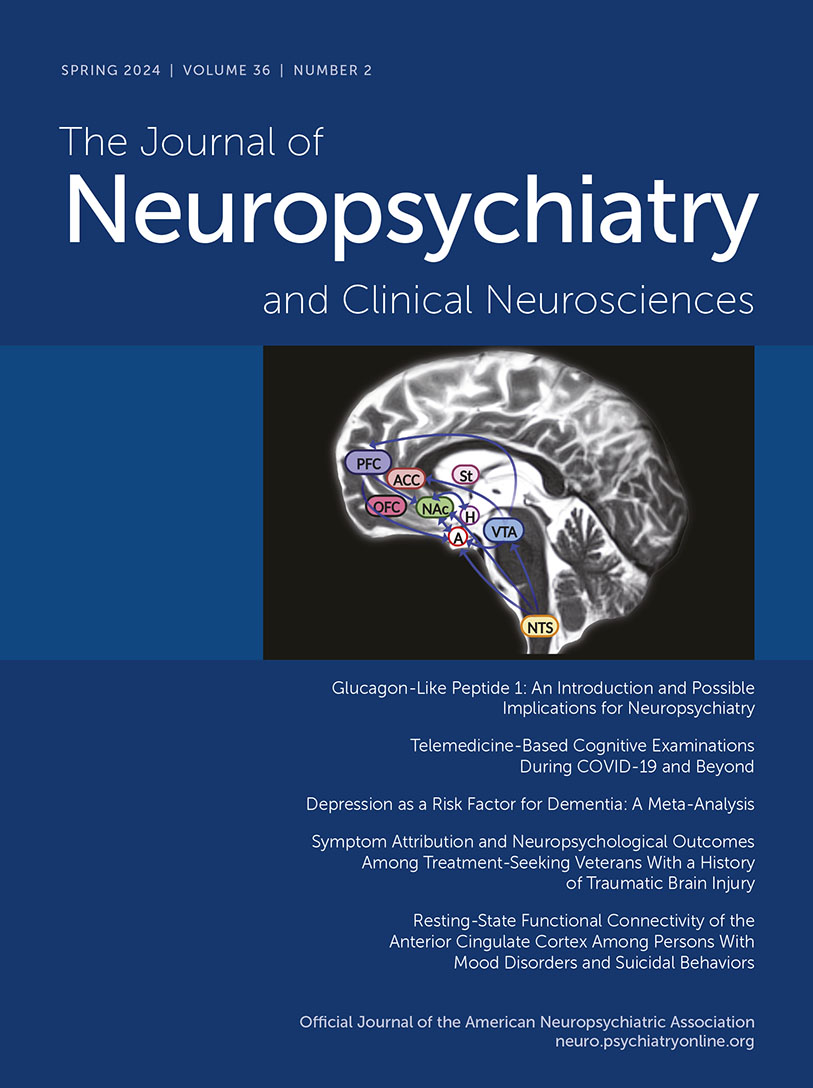Creating a “Brain-Mind-Body Interface Disorders” Diagnostic Category Across Specialties
The COVID-19 pandemic taught us many lessons, including the interconnection between physical and mental health. This observation is not new, however; the intersection of physical and mental health is discussed in early medical writings. At the origins of modern-day psychiatry and neurology, there was great interest in the condition now called functional neurological disorder (FND) (1, 2). Nonetheless, FND has a complex history, including its evolution from “hysteria” to “conversion” to “psychogenic illness” to “FND”; unfortunately, the condition is also stigmatized and erroneously confused with malingering (3). The recognition that FND is common, an emphasis on a rule-in diagnosis, an improved understanding of mechanisms and etiologies, and an expanding therapeutic toolkit have revitalized the field of FND (4). However, disagreements remain, such as the multiplicity of terms used for the seizure subtype of FND (e.g., psychogenic nonepileptic vs. functional vs. dissociative vs. nonepileptic attacks) (5); to unambiguously connect all functional neurological subtypes to FND, we support use of the term “functional seizures.”
In other specialties, similar transformations have moved away from “medically unexplained” framings. Although certain disciplines have used the qualifier “functional” and this term is well received by some patients and advocacy groups, challenges to a “functional disorders” diagnostic category remain (6). The term “functional gastrointestinal disorders” was changed to “disorders of gut-brain interaction,” in part because “functional” was thought to be too nonspecific (7). The somatic symptom disorder diagnosis has received mixed reviews, and competing terms, such as bodily distress disorders, have arisen (8). These developments have weakened the DSM-5’s “Somatic Symptom and Related Disorders” category. In parallel, the medical literature has codified functional somatic syndromes (e.g., fibromyalgia) with their own diagnostic criteria. Some conditions have been reframed to potentially distance them from a biopsychosocial-informed therapeutic framework (e.g., myalgic encephalomyelitis or chronic fatigue syndrome); conversely, there have been calls to reconceptualize persistent symptoms after mild traumatic brain injury (also known as postconcussive symptoms or postconcussion syndrome) as an “interface disorder of neurology, psychiatry, and psychology” (9).
Here, we make the case for a “brain-mind-body interface disorders” diagnostic category spanning medical specialties; this category represents conditions with physical symptoms where there is likely a therapeutic benefit to factor in psychological processes (e.g., biased attention, fear avoidance, somatic hypervigilance, illness beliefs, alexithymia, catastrophizing, impaired self-agency, and dissociation) as core to the development or maintenance of symptoms (Figure 1) (10, 11).

FIGURE 1. Brain-mind-body interface disorders: examples of conditions with and without a core brain-mind-body interface componenta
aCore brain-mind-body interface disorders involve the likely therapeutic benefit of considering the interplay of psychological processes (e.g., biased attention, fear avoidance, or catastrophizing) in promoting the development or maintenance of physical symptoms. Brain-mind-body interface disorders generally require the patient to be an active agent of change (treatment is not delivered passively to the patient). Successful therapeutic interventions for neuropsychiatric conditions without a core brain-mind-body interface component do not explicitly require consideration of mechanistically important psychological constructs (e.g., surgical removal of an ovarian teratoma to treat anti-N-methyl-d-aspartate receptor encephalitis). Conditions in the overlapping circles are those that have the potential to be shifted to the left or the right dependent on patient-specific characteristics. For example, individuals with major depression, limited dysphoria, and prominent somatic symptoms and people with severe panic attacks with prominent tremulousness and dissociation could be shifted to the brain-mind-body interface disorders category. Note that the framing of a given diagnosis as “in” or “out” of the brain-mind-body interface disorders category is likely to evolve over time with therapeutic, mechanistic, and etiological advances.
Helping Patients Understand the Diagnosis and Engage With Treatments
Communication of and a general receptiveness to the diagnosis of a condition in this category by patients and family members are critical steps in treatment. For a conversation about the diagnosis to be comprehensive, in our opinion, the intersection of brain, mind, and physical symptoms should be addressed—a “functional disorder” framework without further clarification does not explicitly identify this relationship. With a given diagnosis falling into the brain-mind-body interface disorders category, providers can introduce the notion that a particular condition sits at the interface of brain, mind, and body—a concept that challenges sociocultural norms of health and disease. It is important to validate the patient’s symptoms as genuine and common while facilitating a transition to a repertoire of complementary physical (e.g., physiotherapy) and mental health (e.g., psychotherapy) treatments. Recognizing that brain-mind-body interface disorders exist on a spectrum is essential to understanding why some patients will improve with treatments primarily targeting physical health, whereas others may benefit from mental health interventions. Importantly, physical health interventions, such as physiotherapy, are psychologically informed when applied to patients with brain-mind-body interface disorders (12).
Increasing Access to Care
Brain-mind-body interface disorders lack a medical home, with disagreements among clinicians and patients alike regarding whether the condition is “physical,” “psychological,” or both. Although the relevance of medical and neurological, psychiatric and psychological, and sociocultural-spiritual factors varies across individuals based on their biopsychosocial-informed “personal equation” for the development and maintenance of their condition, a defining characteristic of brain-mind-body interface disorders is a nuanced, and at times overt, interplay between one’s physical and mental health. As such, a diagnostic category that goes across specialities should facilitate team-based (multidisciplinary and interdisciplinary) care in this patient population. Also, a term that helps eradicate dualistic thinking (e.g., “organic” vs. “nonorganic”) offers advantages in promoting a patient-centered approach from the start (13). Neuroscientifically, structure-function relationships are closely coupled, suggesting that functional disorders are essentially also structural disorders, with the distinction being one of scale (macro vs. micro).
Connecting to the Broader Diagnostic Category
The naming of a condition—fraught with a multiplicity of considerations—occurs through an interplay between scientific advances, professional and patient advocacy organizations, and funding bodies. The brain-mind-body interface disorders framework allows inclusion of a range of conditions cared for across specialties (e.g., noncardiac chest pain) whether or not those conditions are explicitly identified with the qualifier “functional.” The identity of each disorder can be preserved, along with the acknowledgment of a connection with other brain-mind-body interface disorders. This approach also offers the advantage of bringing together different organizations for shared advocacy (e.g., interdisciplinary research and programmatic funding). Furthermore, the term “functional disorders” is not universally synonymous with brain-mind-body interface disorders (e.g., functional disorders of the gallbladder). Similarly, functional medicine is a medical specialty that is not specifically related to the care of functional disorders.
Cohesively Framing Incompletely Understood Mechanisms and Etiologies
Brain-mind-body interface disorders are etiologically and mechanistically heterogeneous. For example, childhood maltreatment is a risk factor for FND and somatic symptom disorders, yet not all individuals with these conditions endorse adverse life experiences (14). For others, risk factors or triggers for these disorders may relate to perfectionistic traits, physical injury (drawing attention to the body), pathological health anxiety, sensory processing difficulties, autism spectrum disorder, or intellectual disability, among other possibilities (15).
Reducing Iatrogenic Harm
Another challenge is to identify a diagnostic category that proves validating and therapeutically helpful while providing the health care system with an understanding of the scope of a given patient’s symptom complex. For individuals with a brain-mind-body interface disorder, the symptoms attached to a specific diagnostic label must be clearly specified. Excessive (or premature) diagnostic anchoring of new symptoms without an appropriate workup is fraught with potential medical errors. This issue is likely relevant to whatever term is reached through consensus, underscoring the need for more education.
Conclusion
In summary, we call for operationalizing a brain-mind-body interface disorders diagnostic category, given its transparency in highlighting the interplay between the brain, mind, and body that is likely therapeutically (and mechanistically) foundational to these conditions. Surveying a range of stakeholders will be important because such terminological considerations have important medical and societal implications.
1. : A review and expert opinion on the neuropsychiatric assessment of motor functional neurological disorders. J Neuropsychiatry Clin Neurosci 2021; 33:14–26Link, Google Scholar
2. : Evidence-based practice for the clinical assessment of psychogenic nonepileptic seizures: a report from the American Neuropsychiatric Association Committee on Research. J Neuropsychiatry Clin Neurosci 2021; 33:27–42Link, Google Scholar
3. : Why functional neurological disorder is not feigning or malingering. Nat Rev Neurol 2023; 19:246–256Crossref, Medline, Google Scholar
4. : Functional neurological disorder: new subtypes and shared mechanisms. Lancet Neurol 2022; 21:537–550Crossref, Medline, Google Scholar
5. : How to do things with words: two seminars on the naming of functional (psychogenic, non-epileptic, dissociative, conversion, …) seizures. Seizure 2021; 93:102–110Crossref, Medline, Google Scholar
6. : “Functional disorders”: one of medicine’s biggest failures. BMJ 2023; 380:221Crossref, Medline, Google Scholar
7. : What is new in Rome IV. J Neurogastroenterol Motil 2017; 23:151–163Crossref, Medline, Google Scholar
8. : A European research agenda for somatic symptom disorders, bodily distress disorders, and functional disorders: results of an estimate-talk-estimate Delphi expert study. Front Psychiatry 2018; 9:151Crossref, Medline, Google Scholar
9. : Reframing postconcussional syndrome as an interface disorder of neurology, psychiatry and psychology. Brain 2022; 145:1906–1915Crossref, Medline, Google Scholar
10. : What’s in a name? Epilepsy Behav 2020; 112:107364Crossref, Medline, Google Scholar
11. : Guided self-help for functional (psychogenic) symptoms: a randomized controlled efficacy trial. Neurology 2011; 77:564–572Crossref, Medline, Google Scholar
12. : Psychologically informed physical therapy for children and adolescents with functional neurological symptoms: the wellness approach. J Neuropsychiatry Clin Neurosci 2020; 32:389–395Link, Google Scholar
13. : “Organic” and “non-organic”: a tale of two turnips. Pract Neurol 2017; 17:417–418Crossref, Medline, Google Scholar
14. : Stressful life events and maltreatment in conversion (functional neurological) disorder: systematic review and meta-analysis of case-control studies. Lancet Psychiatry 2018; 5:307–320Crossref, Medline, Google Scholar
15. : Physical precipitating factors in functional movement disorders. J Neurol Sci 2014; 338:174–177Crossref, Medline, Google Scholar



